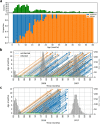Population-based serology reveals risk factors for RSV infection in children younger than 5 years
- PMID: 33903695
- PMCID: PMC8076290
- DOI: 10.1038/s41598-021-88524-w
Population-based serology reveals risk factors for RSV infection in children younger than 5 years
Abstract
Respiratory syncytial virus (RSV) infection is a leading cause of hospitalization in infants. Underlying risk factors for RSV infection in the general population are not well understood, as previous work has focused on severe outcomes of infection in a clinical setting. Here we use RSV-specific IgG and IgA antibody measurements from two population-based cross-sectional serosurveys carried out in the Netherlands (n = 682) to classify children up to 5 years as seronegative or seropositive. We employ a generalized additive model to estimate the probability of prior RSV infection as function of age, date of birth within the year, and other risk factors. The analyses show that the majority of children have experienced a RSV infection before the age of 2 years. Age and birthdate are strong predictors of RSV infection in the first years of life, and children born in summer have higher estimated probability of infection than those born in winter [e.g., 0.56 (95% CI 0.45-0.66) vs. 0.32 (0.21-0.45) at age 1 year]. Our analyses reveal that the mean age at infection depends on date of birth, which has implications for the design of vaccination programmes and prioritisation schemes for the prophylactic use of monoclonal antibodies.
Conflict of interest statement
The authors declare no competing interests.
Figures




References
-
- RSV Vaccine and mAb Snapshot—PATH Vaccine Resource Library. Accessed 16 Apr 2021. http://vaccineresources.org/details.php?i=1562.
Publication types
MeSH terms
Substances
LinkOut - more resources
Full Text Sources
Medical
Miscellaneous

